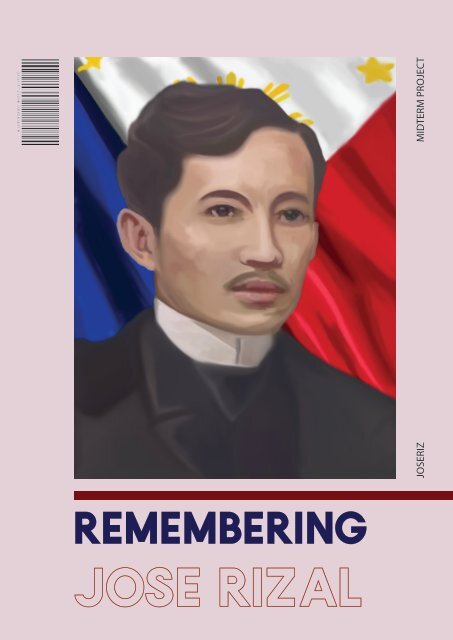RIZAL-MIDTERMS
Create successful ePaper yourself
Turn your PDF publications into a flip-book with our unique Google optimized e-Paper software.
JOSERIZ MIDTERM PROJECT<br />
REMEMBERING<br />
JOSE <strong>RIZAL</strong>
JOSE <strong>RIZAL</strong>’S<br />
SECONDARY<br />
EDUCATION IN<br />
ATENEO<br />
The Jesuits were considered the<br />
best educators of Spain, and<br />
perhaps of Europe, and so, when<br />
they were permitted to return to<br />
the Philippines, although their<br />
power to administer parishes was<br />
restricted except in the remote<br />
regions of Mindanao, the<br />
privilege of founding colleges,<br />
they had to apply to the City of<br />
Manila for subsidies. That is why<br />
the college which began to<br />
function in the year 1865, was<br />
called the Ateneo Municipal.
Jesuit System of Education the system of education given by the<br />
Jesuits in the Ateneo was more advanced than that of other<br />
colleges in that period It trained the student by rigid discipline<br />
and religious instruction. During that time, Jesuit Colleges were<br />
established to stimulate learning and competition among the<br />
students. Students were divided: one was Roman and<br />
Carthaginian or Greek, constantly at war, and in which the<br />
highest positions were won by challenges that were successful<br />
when the opponent made three mistakes.<br />
Ateneo Municipal A college<br />
under the supervision of the<br />
Spanish Jesuits Bitter rival of the<br />
Dominican-owned College of<br />
San Juan de Letran Escuela Pia<br />
(Charity School), A school for<br />
poor boys in Manila Established<br />
by the city government in 1817.<br />
Ateneo de Manila Acquired<br />
prestige as an excellent college<br />
for boys.
Jose was sent to Manila four months after the friars Gomez,<br />
Burgos, and Zamora were martyred - after his primary education<br />
in Binan. Jose's father had intended him to study at Letran, but<br />
changed his mind and sent him to the Ateneo instead.<br />
Rizal Enters the Ateneo Father Magin Ferrando, who<br />
was the school registrar, refused to admit him for two<br />
reasons:<br />
1) He was late for registration<br />
2) He was sickly and undersized for his age. However, upon the<br />
intercession of Manuel Xerez Burgos, nephew of Father Burgos,<br />
he was reluctantly admitted at the Ateneo which was located at<br />
Intramuros, outside the walls of Manila.
<strong>RIZAL</strong>’S FIRST YEAR<br />
Jose Rizal’s First Year in Ateneo (1872-1873).<br />
Fr. Jose Bech - first professor in Ateneo - “Tall, thin man,<br />
with a body slightly bent forward, a harried walk, an ascetic<br />
face, severe ad inspired, small seep-sunken eyes, a<br />
sharp nose that was almost Greek, and thin lips forming<br />
an arc whose end fell toward the chin.”<br />
Belonged to the Carthaginians in which he was an<br />
externo.<br />
Took private lessons in Santa Isabel College during the<br />
noon recesses to improve his Spanish, which was actually<br />
3 pesos per session
<strong>RIZAL</strong>’S SECOND YEAR<br />
Second Year in Ateneo (1873-1874).<br />
Once more, he became “emperor”.<br />
Three of his new classmates were boys from Biñan, who<br />
had been his classmates in the school of Maestro<br />
Justiniano.<br />
Received excellent grades in all subjects and a gold medal<br />
at the end of the school year.
Third Year in Ateneo (1874-1875).<br />
<strong>RIZAL</strong>’S THIRD YEAR<br />
Rizal did not make an excellent showing in his studies as in<br />
the previous year.<br />
His grades remained in all subjects, but he won only one<br />
medal—in Latin.<br />
He failed to win the medal in Spanish because his spoken<br />
Spanish was not fluently sonorous and was beaten by a<br />
Spaniard who could naturally speak fluently and with right<br />
accentuation.
<strong>RIZAL</strong>’S FOURTH YEAR<br />
Fourth Year in Ateneo (1875-1976) .<br />
Became an interno on June 16, 1875 Fr. Francisco de<br />
Paula Sanchez, one of his professors, who was a great<br />
educator and scholar that inspired the young Rizal to study<br />
harder and to write poetry. He later became an admirer<br />
and friend of the great Calamba lad. Rizal considered<br />
him as his best professor in Ateneo - “model of<br />
uprightness, earnestness, and love for the advancement of<br />
his pupils”.<br />
Topped all his classmates in all subjects and won five<br />
medals at the end of the school term.<br />
Fr. Francisco de Paula Sanchez
Last Year in Ateneo (1876-1877).<br />
The most brilliant Atenean of his time.<br />
“The pride of the Jesuits”.<br />
<strong>RIZAL</strong>’S last YEAR<br />
Obtained the highest grades in all subjects—philosophy,<br />
physics, biology, chemistry, languages, mineralogy, etc.<br />
Graduation with Highest Honors Rizal graduated at the<br />
head of his class.
JOSERIZ<br />
MIDTERM PROJECT<br />
CREATED BY:<br />
AMANCIO, ISABEL ALLEN<br />
ARVISU, SABINA BEATRIX<br />
BAUTISTA, JUAN MIGUELLE CARLITOS<br />
BUENDIA, JEREMY CHRISTIAN<br />
CERENO, JEMIMA JOELLE<br />
LGE01


